Backyard bounty
It’s nature’s planting time. While the air starts to cool down in autumn, the soil still holds onto summer’s warmth. For plants, this means perfect growing conditions and they respond with a generous flourish of pre-winter growth, especially where it matters most - below ground in the root zone. As long as they have water, trees that are planted in autumn make a good start before the cold weather arrives, sending out strong new roots that will be all set to support the shoot and leaf growth that erupts in spring. Planting in autumn or early winter effectively saves water because well-established roots are less dependent on watering during their first year in the ground.
Autumn is a great time to plant almost anything, including the trees that will feed the family for many years to come. Apart from the absolute freshness and convenience of having beautiful fruit to pick in your own backyard, another key advantage is that you can grow something different from the varieties that are commonly available at the shops.
The iCan Harvest collection prides itself on excellent home garden varieties you won’t see in supermarkets. Exceptional home garden performance and beautiful tasting fruit are key criteria in the iCan Harvest fruit selection.
Ican Harvest trees are also chosen for their compact growth habits, meaning more fruit can be grown in less space. Many are suitable for growing in large containers. Modern breeding has produced high yielding plants that pack a huge amount of fruit onto their compact frames. Small trees don ’t have to mean less fruit! Here are a few of our favourites.
Croquella apple
Ideal for a large pot or smaller garden, ‘Croquella’ is a natural dwarf apple tree that reaches (in 5 years) no more than 2.5m tall and wide while producing high yields of big crunchy apples every autumn. The fruit is juicy and has excellent flavour. The tree is partially self-fertile with fruit ready for harvest in March when the bright green skin takes on a flush of red.
Oddfellow peach
Peach 'Oddfellow' is a premier peach variety. In summer the tree produces a load of golden yellow flat shaped fruit that’s firm, juicy and wonderfully sweet. In spring the large light pink blossoms make a fabulous show on this strong healthy tree.
Luisa plum
One of the sweetest plums, Luisa is loved for her large juicy yellow-fleshed fruit. Heart shaped with a distinctive dimple and glowing yellow-orange skin. Get it off to a good start with careful autumn planting and your Luisa plum will reward you with bounteous crops from a young age.
This deciduous, spreading tree will grow to around 5m tall and 3m wide depending on pruning. It is self-fertile so it will not need another tree to produce fruit. Luisa has pretty white flowers in early spring and fruit that’s ready to pick in January and February.
Takaka feijoa
This delicious large-sized feijoa ripens earlier than other feijoas, which makes it a good choice for growing in marginal cooler regions. This attractive evergreen is hardy, vigorous and partially self-fertile, which means it will produce fruit on its own but will yield even better crops when planted near any other feijoa variety. Takaka grows quickly, reaching approximately 3m in 10 years. The fruit has a rich tropical flavour.
Lemonade lemon
There’s no need to add sugar to enjoy this lovely lemon. You can eat the sweet, low-acid segments straight from the tree. As its name suggests it is perfect for homemade lemonade. Use it in desserts, in summer drinks and salad dressings. Some say the Lemonade lemon is a hybrid of Meyer lemon and a mandarin, but the genetic origin of this kiwi isn’t known for sure. It was discovered in New Zealand in the 1980’s. While it prevails in many kiwi gardens, the fruit is really found in shops as it is not grown commercially.
The Lemonade tree is smaller than most lemon trees with fragrant flowers and rounded fruit that turns bright yellow as it matures. Lemonade lemon thrives in a sunny, frost free location.
Tips:
- Apply an organic mulch regularly to conserve moisture and suppress weeds.
- Feed with balanced controlled release fertiliser at planting time and each year in spring as new growth begins.
Planning a fruitful garden
- Grow the best varieties for your climate. Ask your garden centre for the best varieties to grow in your climate.
- Pay attention to pollination. Check if your chosen variety needs a pollinator variety for peak productivity. If there is no room for it in your garden, maybe you can collaborate with neighbours or choose a self fertile variety. Grow flowers that will help attract pollinators to your fruit trees.
- Spread the harvest. Plant trees that fruit at different times of year so there is always something to pick.
- Grow the fruit the family most enjoys eating, it’s also worth sacrificing trees that produce something you don’t especially enjoy. Involve the whole family in prioritising which fruit trees should be at the top of your shopping list.
- Embrace change and replace old under-performing trees. If the fruit is of poor quality and the yield is low, it might be time to say goodbye and make space for something new.
Growing fruit trees in pots
Fruit trees grow best in the ground, but if you plan on taking them with you when you move or if you have limited space, containers are a good option. Trees in pots need more care and attention than they would if their roots ran free in the earth, but give them some sun and see to their water and nutritional needs and they’ll reward you with plenty to pick.
Choose smaller trees. Smaller growing fruit tree varieties may be naturally dwarf varieties or grafted onto a dwarfing rootstock.
Choose bigger pots. The larger the container the more nutrients and water it can hold, so the more fruit it can support. Half wine barrels are ideal. Large ceramic pots are also very attractive but heavy. Plastic tubs are lighter and easier to move about. Sitting heavy pots on casters makes them easier to move about and helps with drainage.
Invest in fresh, top quality planting mix. Garden soil is not the best option for pots. The better the mix, the longer it will last and the better your trees will grow. The best mixes have excellent water holding capacity but drain freely.
Water regularly. In hot dry weather daily watering is best. Generally, it’s time to water when the top cm of potting mix becomes dry to touch. Take the time to water thoroughly. When potting leave enough space for water to pool and soak in. Old or dry potting mix repels water. Apply a wetting agent to help water soak thoroughly throughout the potting mix.
Feed them well. To optimise fruiting, choose balanced fertilisers designed for fruit trees in pots. Fertilisers too high in nitrogen can lead to excessive leafy growth at the expense of fruit. Seaweed solution used in conjunction with fertiliser helps maintain healthy root function.
Transplant or repot. After three to five years in a container it’s common for a tree to become stressed. At this stage they it be transplanted into the garden, a bigger pot, or returned to the same pot with pruned roots and fresh potting mix. The top growth should also be pruned to promote new growth and relieve stress on the roots as the tree settles into new growth. Water thoroughly after repotting.
How to plant a tree
Extra care at planting time may not be a matter of life and death. However, it is often the difference between rapid establishment and a slow, lacklustre start. A poorly planted tree or shrub may never reach its full potential. Choose healthy, well-grown, plants.
Always read the plant label to make sure it suits your site and soil conditions - ‘the right plant for the right place ’ is a key factor in survival and performance. Fruit trees perform best in a sunny location with shelter from strong wind. Check for frost tenderness and drought tolerance.
- Water thoroughly to ensure the plant ’s root ball is completely saturated before planting. This can be done by soaking the rootball in a bucket of water before removing it from its container.
- Dig a hole twice the diameter of the root ball and add some long term controlled-release fertiliser.
- Remove the plant from its container, taking care not to damage the roots. Use clean sharp secateurs to cut off any damaged roots.
- Place the plant in the hole with the top of the root ball at ground level, adjusting the soil level in the base of the hole to accommodate the plant at the correct level. Plant the tree at the same depth it was in its container. Take care not to bury the graft (the knobbly part above roots). Plant only as deep as the top of the root ball. Ideally one person will hold the tree in the right position while another person back fills the hole with soil. Tread firmly then water throughly to bring the soil into close contact with the roots.
- Staking is recommended, especially for windy locations. This helps to anchor young trees while the roots get established. Use wide flexible ties to hold the tree securely without damaging the bark and allowing for the trunk to grow without constriction. Space two or three stakes evenly around the tree, just outside the root ball. A single stake can result in damage via the tree rubbing against the stake.
- Mulch with fine bark or compost to help retain moisture and protect roots from drying out.

28-Feb-2021


Apple Croquella
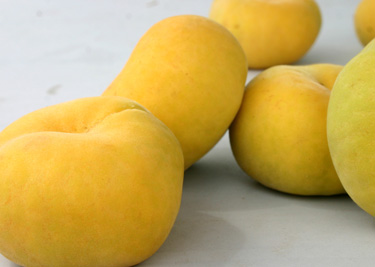
Peach Oddfellow
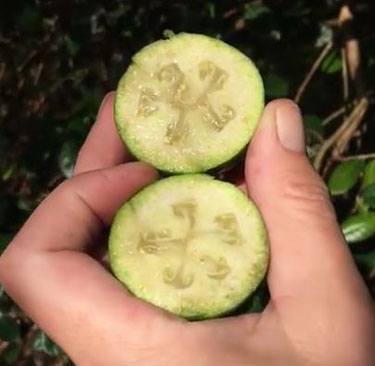
Feijoa
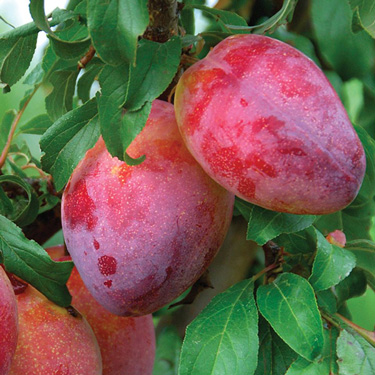
Plum Luisa
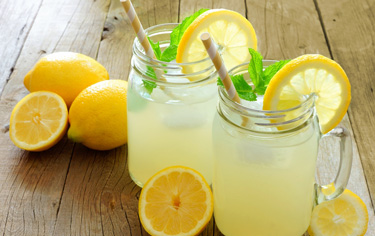
Lemonade
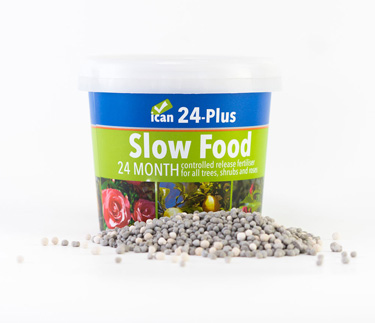
ican Slow Food is perfect for feeding fruit trees for up to 24 months. Available from your local ican garden centre.

